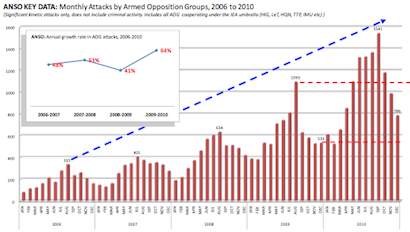By Jonathon Burch
Reuters Canada

KABUL (Reuters) – Foreign military assertions that security in Afghanistan is improving are intended to sway Western public opinion ahead of a troop withdrawal and do not reflect the reality on the ground, a security advice group said.
“Indisputable evidence” that conditions are deteriorating included a two-thirds rise in insurgent attacks in 2010 compared with the previous year, according to the EU-funded organization, that advises aid groups on safety.
In one northern province raids more than tripled, the group said in a report.
A war review by U.S. President Barack Obama last month said “notable operational gains” had been made and the Taliban’s momentum arrested in much of the country and reversed in some areas, but gains were fragile and reversible.
Those findings have been echoed by military commanders on the ground. On Wednesday, General David Petraeus, commander of U.S. and NATO-led forces, delivered an upbeat assessment of 2010 in a message to foreign troops and civilians.
“Throughout the past year, you and our Afghan partners worked together to halt a downward security spiral in much of the country and to reverse it in some areas of great importance,” Petraeus said in the message.
The Afghanistan NGO Safety Office (ANSO), which advises non-governmental organizations (NGOs) on security, said positive “strategic communication” messages were only aimed at preparing the way for troop withdrawals scheduled to start this year.
“No matter how authoritative the source of any such claim, messages of this nature are solely intended to influence American and European public opinion ahead of the withdrawal,” the group said in its quarterly report, designed to help aid groups make decisions involving security.
“(The messages) are not intended to offer an accurate portrayal of the situation for those who live and work here,” the group said. The report is not released to media but Reuters obtained a copy. (Click here for a copy of the ANSO report.)
Obama has pledged to begin gradually withdrawing U.S. troops in July, as Afghan forces slowly take control over security.
This is part of a wider plan by President Hamid Karzai for Afghans to take the lead in securing the whole country by the end of 2014, an ambitious goal endorsed by Western leaders, who are under domestic pressure to bring forces home.
ANSO found militant attacks were up 64 percent last year compared with 2009, and an average of 33 incidents had taken place every day. While violence may have decreased in some areas, it had dramatically increased in others, the group added.
“If losses are taken in one area they are simply compensated for in another as has been the dynamic since this conflict started,” ANSO said.
Casualty numbers on all sides are at record levels. A total of 711 foreign troops were killed in 2010, by far the bloodiest year of the war and up from 521 in 2009.
But ordinary Afghans bear the brunt. According to U.N. figures, 2,412 civilians were killed and 3,803 were wounded in the first 10 months of last year, up 20 percent on 2009.
The insurgency has also been rapidly spreading out of traditional strongholds in the south and east of the country and into previously peaceful areas in the north and west.
Militant attacks in six northern provinces increased faster than the average for all of Afghanistan, more than doubling in five and tripling in Sar-e-Pol, ANSO said.
In the south, where foreign and Afghan forces have stepped up offensives over the last year, the increase in insurgent attacks suggested the capacity for militants to conduct raids had “improved substantially.”
Helmand province saw a 124 percent increase while attacks rose by 20 percent in Kandahar, it said.
Although there had been a decline in attacks from August onwards, this most likely reflected seasonal factors consistent with previous years, ANSO said, and attacks in December 2010 were 47 percent higher than in December the previous year.
(Editing by Robert Birsel)
© Thomson Reuters 2011 All rights reserved.



